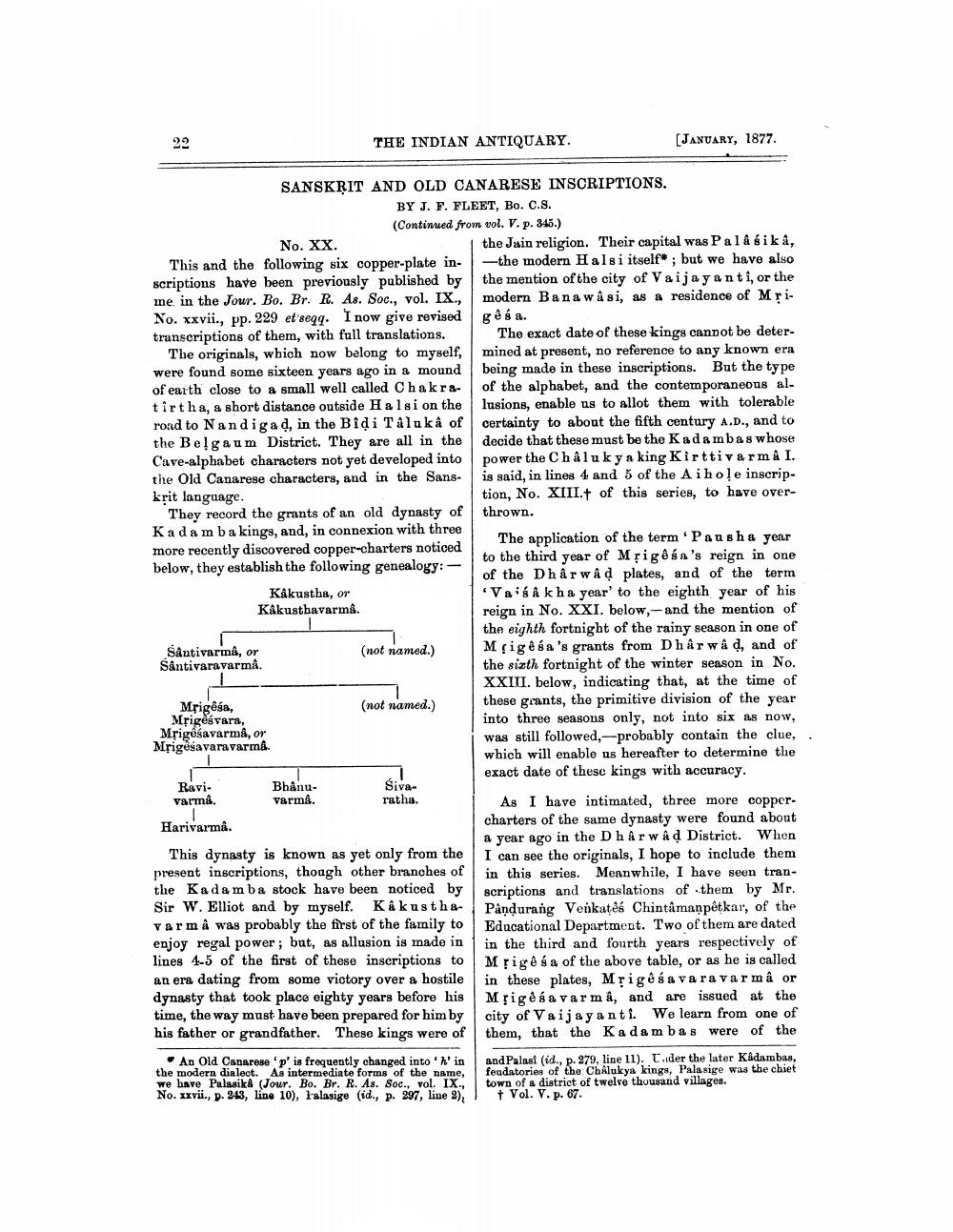________________
THE INDIAN ANTIQUARY.
[JANUARY, 1877.
SANSKRIT AND OLD CANARESE INSCRIPTIONS.
BY J. F. FLEET, Bo. C.8.
(Continued from vol. V. p. 346.) No. XX.
the Juin religion. Their capital was Pal & bika, This and the following six copper-plate in the modern Halsi itself* ; but we have also scriptions have been previously published by the mention of the city of Vaijayanti, or the me in the Jour. Bo. Br. R. As. Soc., vol. IX., modern Bana w â si, as a residence of MriNo. xxvii., pp. 229 et seqq. I now give revised
gesa. transcriptions of them, with full translations. The exact date of these kings cannot be deter
The originals, which now belong to myself, mined at present, no reference to any known era were found some sixteen years ago in a mound being made in these inscriptions. But the type of earth close to a small well called Chakra of the alphabet, and the contemporaneous al. tirtha, a short distance outside Halsi on the lusions, enable us to allot them with tolerable road to Nandigad, in the Bidi Taluka of certainty to about the fifth century A.D., and to the Belgaum District. They are all in the decide that these must be the Kadambas whose Cave-alphabet characters not yet developed into power the Châluky a king Kirttivarm & I. the Old Canarese characters, and in the Sans- is said, in lines 4 and 5 of the A i hoļe inscripkrit language.
tion, No. XIII. of this series, to have overThey record the grants of an old dynasty of thrown. Kadamba kings, and, in connexion with three
The application of the term 'Pausha year more recently discovered copper-charters noticed
to the third year of Mrigêśa's reign in one below, they establish the following genealogy: -
of the Dharwad plates, and of the term Kakustha, or
"Vaig å kha year' to the eighth year of his Kakusthavarma.
reign in No. XXI. below,- and the mention of
the eighth fortnight of the rainy season in one of Sântivarma, or
(not named.) Migé sa 's grants from Dharwad, and of Sântivaravarma.
the sixth fortnight of the winter season in No.
XXIII. below, indicating that, at the time of Mrigesa,
(not named.)
these grants, the primitive division of the year Mrigesvara,
into three seasons only, not into six as now, Mpigêśavarma, or Msigesavaravarma.
was still followed, probably contain the clue, . which will enable us hereafter to determine the
exact date of these kings with accuracy. Ravi.
BhânuVarmå. Varmå. ratha.
As I have intimated, three more copperHarivarma.
charters of the same dynasty were found about
a year ago in the Dharwad District. When This dynasty is known as yet only from the I can see the originals, I hope to include them present inscriptions, though other branches of in this series. Meanwhile, I have seen tranthe Kadamba stock have been noticed by scriptions and translations of them by Mr. Sir W. Elliot and by myself. Kakustha- Pandurang Venkates Chintamanpetkar, of the varm â was probably the first of the family to Educational Department. Two of them are dated enjoy regal power; but, as allusion is made in in the third and fourth years respectively of lines 4-5 of the first of these inscriptions to Mrige sa of the above table, or as he is called an era dating from some victory over a hostile in these plates, Mrigê sa va ravar mâ or dynasty that took place eighty years before his Mrigesa varma, and are issued at the time, the way must have been prepared for him by city of Vaijayanti. We learn from one of his father or grandfather. These kings were of them, that the Kadam bas were of the
Siva
An Old Canaresep is frequently changed into 'Nin the modern dialect. As intermediate forms of the name, we have Palasika (Jour. Bo. Br. R. As. Soc., vol. IX., No. xxvii., D. 943, line 10), l'alasige (id., p. 297, line 2),
and Palasi (id., p. 279, line 11). C.der the later Kadambas, feudatories of the ChAlukya kings, Pala sige was the chiet town of a district of twelve thousand villages.
Vol. V. p. 67.




